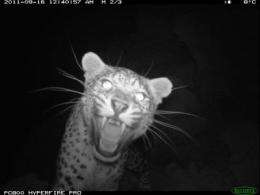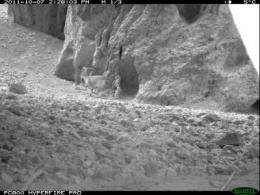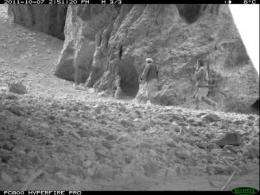WCS confirms the return of the Persian leopard In Afghanistan's central highlands

Recent camera trap images from the rocky terrain of Afghanistan's central highlands have revealed a surprise: a Persian leopard, an apex predator long thought to have disappeared from the region, according to the Wildlife Conservation Society.
In a series of images that provides indisputable proof that the big cat persists in the country's interior, a big adult leopard can be seen prowling around the camera trap's field of view and investigating the camera itself, appearing to threaten it with canines exposed.
The camera traps captured dozens of images of other wildlife species, including lynx, wild cat, wolf, red fox, and stone marten, an impressive suite of predators still surviving in the Hindu Kush highlands, where Wildlife Conservation Society scientists and Afghan rangers have been conducting surveys in recent months.

"To see such a varied array of wildlife after we have endured so much conflict gives us hope for Afghanistan's future," said Mostapha Zaher, Director General of Afghanistan's National Environmental Protection Agency. "Intact ecosystems represent a foundation for our country's reconstruction and development. This is also our heritage, our natural resources, our fauna and flora. It is incumbent upon all of us to conserve and protect our environment and hand it over to the next generation of the citizens of Afghanistan."
Camera traps give conservationists a valuable research tool in remote wildlife areas. In addition to providing a cross-section of an ecosystem in terms of the presence and absence of wildlife, the devices record data that, in sufficient quantities and placement, can be used to generate population estimates for individual species.

"The presence of leopards and lynxes in Afghanistan tells us that these big cats are finding enough prey to survive," said Ghani Ghuriani, Deputy Minister of Agriculture, Irrigation and Livestock. "This means that the rangelands can still support ibex, urial, and other species, which is a good sign for both wildlife and the people of this region who also depend on these grasslands for grazing."
Peter Zahler, Deputy Director of WCS's Asia Program, said: "We are thrilled by these images and the story of survival that they tell, but we were sobered by the fact that the cameras also took photographs of local people walking past with guns. Poaching is still a very real threat, and WCS is committed to helping the Afghan government and local communities protect these rare and beautiful animals."
With the assistance of WCS and in partnership with the United States Agency for International Development (USAID), the government of Afghanistan has launched several initiatives to safeguard the country's wild places and the wildlife they contain. This includes the creation of the country's first and only national park, Band-e-Amir, in 2009, which is co-managed by local villagers and the government. The park provides jobs and revenue from the thousands of tourists who visit each week during the summer months. WCS worked with Afghanistan's National Environment Protection Agency to create the country's first-ever list of protected species, which prohibits the hunting of snow leopards, brown bears, and other wildlife. WCS provides educational workshops for soldiers at Bagram Air Base and other military bases across Afghanistan in an effort to limit illegal wildlife trade in the country that threatens leopards and other fur-bearing animals.
With USAID support, WCS has worked with the Afghan government, UNEP (United Nations Environment Programme), and others to craft new environmental laws and regulations and train government officials in their application. WCS works directly with more than 55 local communities in Afghanistan to better manage their natural resources. WCS staff train and deploy community rangers to monitor wildlife, and patrol the region to stop poaching and enforce the new environmental laws.
Provided by Wildlife Conservation Society
















